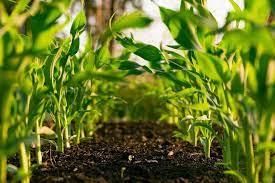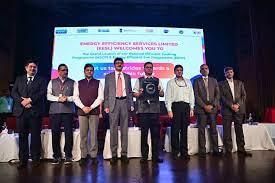Environment & Ecology - 5 | Current Affairs & Hindu Analysis: Daily, Weekly & Monthly - UPSC PDF Download
| Table of contents |

|
| Air Pollution In Urban India |

|
| Cloud Seeding |

|
| United Nations Forum On Forests |

|
| Organic Farming |

|
| National Efficient Cooking Programme |

|
Air Pollution In Urban India
As extensive areas of North India, encompassing states such as Bihar, Uttar Pradesh, Uttarakhand, Haryana, Delhi, and Punjab, contend with dense fog, the India Meteorological Department (IMD) has been issuing alerts and warnings to keep residents abreast of the prevailing conditions. This article aims to elucidate the scientific basis of these warnings and the pivotal role played by the INSAT 3D satellite in furnishing essential data for fog monitoring.
Foggy Conditions in North India
- Persistent Fog: Since December 2023, extensive areas of North India have been enveloped in dense fog.
- IMD Warnings: On January 16, the IMD issued alerts regarding "very dense fog" in several states, including Haryana, Chandigarh, Delhi, Uttar Pradesh, Punjab, and Madhya Pradesh, anticipating visibility to fall below 50 meters during night and morning hours.
Interpreting Satellite Imagery
- INSAT 3D Insights: The INSAT 3D satellite plays a crucial role in monitoring fog conditions through imagery.
- Solar Reflectance and Brightness Temperature: The colors in these images are influenced by two factors: solar reflectance and brightness temperature.
- Solar Reflectance: Reflects the amount of solar energy reflected by a surface concerning the energy it receives.
- Brightness Temperature: Relates an object’s temperature to the brightness of its surface, measured across various wavelengths.
Day Microphysics Data
- Solar Reflectance at Three Wavelengths: INSAT 3D's 'day microphysics' component examines solar reflectance at three wavelengths: 0.5 µm (visible radiation), 1.6 µm (shortwave infrared radiation), and 10.8 µm (thermal infrared radiation).
- Color Determination: The intensity of signals at these wavelengths determines the RGB (red-green-blue) colors in the image.
- Applications: These images aid in the analysis of cloud types, thunderstorm stages, snow identification, and fire detection.
Night Microphysics Data
- Complex Color Determination: INSAT 3D’s ‘night microphysics’ component derives two colors from the difference between two thermal infrared signals.
- Color Variables: Red color depends on the difference between 12 µm and 10 µm signals, green on 10.8 µm and 3.9 µm signals, and blue on the strength of the 10.8 µm signal.
- Identifying Features: Night microphysics data aids in identifying cloud types and their temperature differences.
Combining Day and Night Data
- Comprehensive Insights: Meteorologists combine day and night microphysics data to study moisture droplets, temperature variations, and track the formation, evolution, and depletion of weather events, including cyclones.
- Advanced Warning Systems: Proposed applications include predicting thunderstorms one to three hours in advance.
Radiometers and Sounders
- Satellite Instruments: INSAT 3D and 3DR use radiometers for spectral measurements and atmospheric sounders for temperature, humidity, and water vapor analysis.
- Improved Technology: These satellites offer significant improvements in spatial resolution and spectral channels compared to their predecessors, enhancing India’s weather monitoring capabilities.
Future Prospects with INSAT 3DS
- Ongoing Progress: The Indian Space Research Organisation is set to launch the INSAT 3DS meteorological satellite in February 2024.
- Expanded Capabilities: This satellite will build upon the achievements of its forerunners, further elevating India's capabilities in weather monitoring and forecasting.
Conclusion
- The INSAT 3D satellite, equipped to capture and analyze day and night microphysics data, assumes a crucial role in monitoring and predicting weather conditions, including instances of heavy fog, in North India.
- Through a comprehensive understanding of the intricate science underlying these satellite images, meteorologists can furnish timely warnings and valuable insights, contributing to public safety and facilitating navigation through challenges posed by severe weather conditions.
- With upcoming advancements, India's meteorological prowess is continuously advancing, ensuring improved preparedness for future weather-related events.
Cloud Seeding
Cloud seeding, a pioneering method to augment rainfall, has garnered attention in a recent research paper published in the Bulletin of the American Meteorological Society. Conducted by the Indian Institute of Tropical Meteorology, Pune, the study reveals the capacity of cloud seeding to enhance precipitation in water-scarce areas, providing optimism for addressing drought conditions.
Key Findings of the Study
CAIPEEX Phase-4 Investigation:
- The Cloud Aerosol Interaction and Precipitation Enhancement Experiment (CAIPEEX phase-4) spanned two years in Solapur, Maharashtra, during the summer monsoons of 2018 and 2019.
- The primary goal was to evaluate the efficacy of hygroscopic seeding in deep convective clouds and formulate a cloud seeding protocol.
- Calcium chloride flares were utilized for cloud seeding.
- The seeding process involved releasing particles triggered by a cloud seeding flare. This was done at the base of warm convective clouds during their growth phase to ensure minimal dispersion of seed particles into the clouds.
- The experiment involved two aircraft for studying cloud parameters and cloud seeding.
Effectiveness of Cloud Seeding:
- Cloud seeding has demonstrated effectiveness in enhancing rainfall under appropriate conditions.
- A random seeding experiment selected 276 convective clouds, with 150 clouds subjected to seeding and 122 left unseeded.
- Cloud characteristics, such as liquid water content and vertical motion, were employed to identify clouds with potential for rainfall.
- Targeted convective clouds were typically over one kilometer deep and likely to evolve into deep cumulus clouds.
Benefits:
Cost-Benefit Ratio:
- The cost of producing water through cloud seeding was approximately 18 paisa per liter during the research experiment.
- The use of indigenous seeding aircraft could reduce costs by more than 50%.
Addressing Drought Conditions:
- While cloud seeding alone cannot fully mitigate droughts, it could contribute to an 18% increase in rainfall, partially addressing water requirements.
- Incorporating cloud seeding into catchment-scale projects could aid in drought management.
Practical Applications:
- Regions like Solapur, which receive low rainfall due to their location on the leeward side of the Western Ghats, stand to benefit significantly from cloud seeding.
- The additional water obtained through cloud seeding has the potential to alleviate water scarcity issues in such areas.
Microphysics and Cloud Characteristics:
- The two-year study aimed to comprehend the microphysics and characteristics of convective clouds suitable for enhancing rainfall.
- It provides comprehensive protocols and technical guidance for planning and conducting cloud seeding in India.
Cloud Variability:
- Not all cumulus clouds respond to cloud seeding; approximately 20-25% can produce rainfall if seeding is executed correctly.
- Cloud microphysics exhibit wide variability, leading to diverse outcomes with cloud seeding.
What is Cloud Seeding?
About:
- It is the process of artificially generating rain by implanting clouds with particles such as silver iodide crystals.
- Cloud seeding uses planes to spray clouds with chemicals to condense smaller particles into larger rain droplets.
Cloud Seeding Methods:
Static Cloud Seeding:
- This method involves introducing ice nuclei, such as silver iodide or dry ice, into cold clouds that have supercooled liquid water droplets.
- The ice nuclei can trigger the formation of ice crystals or snowflakes, which can grow at the expense of the liquid droplets and fall as precipitation.
Dynamic Cloud Seeding:
- Dynamic cloud seeding is a method of inducing rain by boosting vertical air currents.
- The process is considered more complex than static cloud seeding because it depends on a sequence of events working properly.
Hygroscopic Cloud Seeding:
- This method involves spraying fine particles of hygroscopic materials, such as salts through flares or explosives into the base of warm clouds.
- The particles can act as cloud condensation nuclei and increase the number and size of the cloud droplets, which can enhance the reflectivity and stability of the clouds.
Applications:
- Cloud seeding is done to enhance winter snowfall and increase mountain snowpack, which can supplement the natural water supply for communities in the surrounding area.
- Cloud seeding can also be done to prevent hailstorms, dissipate fog, induce rainfall in drought-prone regions, or reduce air pollution.
Challenges:
- Cloud seeding requires the presence of moisture-filled clouds, which are not always available or predictable.
- Cloud seeding does not occur during times when additional precipitation would be problematic, such as times of high flood risk or busy holiday travel periods.
- Cloud seeding may have negative effects on the environment and health, such as altering the natural water cycle, contaminating the soil and water with chemicals, or affecting the local climate.
United Nations Forum On Forests
The Forest Research Institute in Dehradun, Uttarakhand, is the venue for a Country-Led Initiative (CLI) event organized by the Ministry of Environment, Forest and Climate Change, in conjunction with the United Nations Forum on Forests (UNFF).
The objective of the initiative:
- The primary goal of the event is to actively participate in dialogues concerning Sustainable Forest Management and the UN Strategic Plan for Forests (UNSPF), with a specific emphasis on thematic domains associated with forest fires and forest certification.
- Anticipated outcomes include the development of frameworks and recommendations for the management of forest fires and forest certification. These proposals are intended to be deliberated upon during the 19th session of UNFF scheduled for May 2024.
About the United Nations Forum on Forests (UNFF):
- Overview: The UNFF serves as an intergovernmental policy forum dedicated to fostering the responsible management, conservation, and sustainable development of diverse forest ecosystems. Its overarching objective is to reinforce enduring political commitment to these endeavors.
- Establishment: The UNFF was established in 2000 under the auspices of the UN Economic and Social Council. It boasts universal membership, comprising all United Nations Member States.
Key Historical Milestones:
- 1992: Adoption of the "Forest Principles" and Agenda 21 during the UN Conference on Environment and Development.
- Establishment of the Intergovernmental Panel on Forests (1995) and Intergovernmental Forum on Forests (1997) to implement the Forest Principles from 1995 to 2000.
- 2000: UNFF becomes a functional commission of the UN Economic and Social Council.
- 2006: Agreement on four Global Objectives for Forests by the UNFF.
- 2007: Adoption of the UN Non-Legally Binding Instrument on All Types of Forests (Forest Instrument) by the UNFF.
- 2009: Adoption of a decision on financing for sustainable forest management, leading to the creation of a Facilitative Process to reverse a 20-year decline in forest financing, initially focusing on Small Island Developing States (SIDS) and Low Forest Cover Countries (LFCCs).
- 2011: Designation of the International Year of Forests with the theme "Forests for People."
The Four Global Objectives on Forests:
- Reverse the global loss of forest cover through sustainable forest management (SFM).
- Enhance the economic, social, and environmental benefits derived from forests.
- Substantially increase the area of sustainably managed forests.
- Counteract the decline in official development assistance for SFM and mobilize augmented financial resources for its implementation.
Organic Farming
Organic farming constitutes an agricultural methodology prioritizing natural and biological practices for crop cultivation and livestock rearing. It refrains from employing synthetic fertilizers, pesticides, and genetically modified organisms (GMOs). Instead, organic farmers adopt strategies like crop rotation, composting, and biological pest control to preserve soil fertility and manage pests. The overarching objective is to establish a self-sufficient and harmonious ecosystem that offers benefits to both the environment and consumers.
Organic Farming: Products and Certification
The output of organic farming, referred to as organic products, includes a diverse array of fruits, vegetables, grains, and animal products. To ensure the genuineness and quality of these products, they typically undergo a stringent certification process. Two crucial certifications in India are PGS-India (Participatory Guarantee System for India) and NPOP (National Programme for Organic Production).
- PGS- India: PGS- India stands out as a distinctive certification system for organic produce in India. It employs a participatory approach, wherein farmers engage in the verification and certification of each other's produce based on predefined guidelines. This approach fosters trust within local communities and stimulates the growth of organic farming at the grassroots level.
- NPOP: The National Programme for Organic Production (NPOP) is a certification system led by the government, ensuring the adherence of organic products to established national standards. NPOP certification enhances credibility and facilitates organic farmers' access to both domestic and international markets.
Advantages of Organic Farming and Products
Organic farming offers numerous benefits, making it an attractive choice for farmers, consumers, and the environment alike.
Environmental Benefits:
- Reduces soil erosion and degradation.
- Preserves biodiversity and ecosystems.
- Minimizes water pollution and depletion.
- Lowers greenhouse gas emissions.
Health Benefits:
- Organic products are free from harmful chemical residues.
- Rich in nutrients and antioxidants.
- Reduces the risk of certain diseases.
Economic Benefits:
- Empowers local farmers and communities.
- Builds sustainable and resilient agriculture.
- Reduces dependency on costly inputs.
Challenges Encountered in Organic Farming
While organic farming boasts numerous advantages, it grapples with specific challenges that impede its widespread adoption.
- Lower Yields: Organic farming often yields lower crop productivity compared to conventional methods, impacting farmer income.
- Knowledge and Training: There is a lack of awareness and technical know-how about organic farming practices.
- Market Access: Difficulty arises in accessing niche markets and securing premium prices for organic products.
- Certification Costs: The certification process can be expensive for small-scale farmers.
Scopes/Benefits
The scope of organic farming extends beyond sustainable agriculture and environmental protection.
- Climate Change Mitigation: Organic farming practices contribute to climate change mitigation by reducing greenhouse gas emissions and promoting carbon sequestration in the soil.
- Sustainable Development: Organic farming aligns with the principles of sustainable development, fostering social, economic, and environmental well-being.
Disease Management
Organic farming employs various strategies to manage diseases without the use of synthetic chemicals.
- Crop Rotation: Rotating crops disrupts disease cycles, reducing the buildup of pathogens in the soil.
- Biological Controls: Introducing beneficial organisms that prey on pests helps maintain a balanced ecosystem.
Weed Management
Organic farmers use several approaches for weed control without herbicides.
- Mulching: Mulching helps suppress weed growth by creating a physical barrier.
- Hand Weeding: Manual weeding is employed to remove weeds from the fields.
Conclusion
Organic farming stands as a promising solution to address the challenges faced by conventional agriculture while promoting sustainable practices. For UPSC aspirants, understanding the significance of organic farming is essential as it forms part of current environmental and agricultural policies. Embracing organic farming practices can lead to a greener and healthier future for our planet.
National Efficient Cooking Programme
Recently, the Energy Efficiency Services Limited (EESL) introduced its innovative National Efficient Cooking Programme (NECP) and Energy Efficient Fans Programme (EEFP).
About the National Efficient Cooking Programme:
- This initiative is a component of the Clean Cooking Scheme, concentrating on Non-Solar/Electricity-based Induction Cookstoves, aligning with the Go-electric initiative by the Ministry of Power. It introduces induction-based cookstoves with the goal of deploying 20 Lakh Induction cook-stoves across India.
- EESL aims to mitigate the environmental impact of cooking methods, promoting cleaner air and enhanced health for citizens. In collaboration with Modern Energy Cooking Services (MECS), EESL plans to extensively deploy induction cooktops, anticipating increased acceptance and widespread adoption of modern electric cooking devices in Indian kitchens.
- The program provides a cost advantage of 25-30% over traditional cooking methods, ensuring both energy savings and cost-effective cooking solutions.
Key Facts about Energy Efficiency Services Limited:
- Promoted by the Ministry of Power, Government of India, EESL operates as a Joint Venture involving four renowned public-sector undertakings: NTPC Limited, Power Finance Corporation Limited, REC Limited, and POWERGRID Corporation of India Limited.
- Established under the Companies Act, 1956, on 10th December 2009, EESL's mandate is to facilitate market access to energy-efficient technologies, especially in public facilities like municipalities, buildings, agriculture, and industry.
- It implements various schemes of the Bureau of Energy Efficiency, Ministry of Power, and Ministry of New & Renewable Energy, Government of India. Additionally, EESL spearheads market-related activities for the National Mission for Enhanced Energy Efficiency (NMEEE).
|
39 videos|4636 docs|994 tests
|
FAQs on Environment & Ecology - 5 - Current Affairs & Hindu Analysis: Daily, Weekly & Monthly - UPSC
| 1. What are the main causes of air pollution in urban India? |  |
| 2. What is cloud seeding and how does it help in combating air pollution? |  |
| 3. What is the role of the United Nations Forum on Forests in addressing air pollution? |  |
| 4. How does organic farming contribute to reducing air pollution? |  |
| 5. What is the National Efficient Cooking Programme and how does it relate to air pollution? |  |

























